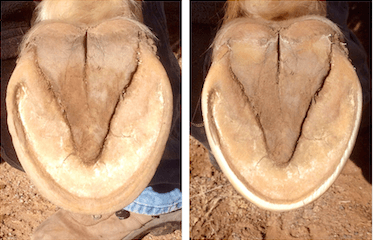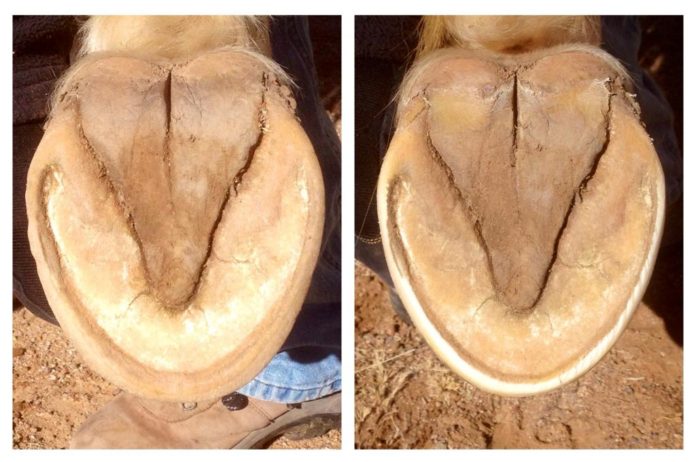Horses’ hooves are highly regenerative. They are designed to be a sustainable structure that not only lasts a lifetime but improves over time. When the horse’s weight is continually and properly balanced over the horse’s hooves and the surface area of every structure receives the correct amount of pressure, you will achieve growth equilibrium. When this is frequently maintained through miles of wear, and/or simulated wear from trimming, the hooves will continually develop over the lifetime of the horse. This means that horses have the ability to have the best feet of their life when they are older. When this is tapped into, the rest of the horse benefits also. There will be less strain on the legs, hips, back, shoulders and neck. This will minimize injuries and allow the horse to become well conditioned with out having to compensate.

Draft cross on 80 acres, Bermuda grass diet, and a two-week trim cycle. Before and after trim.
The benefit to the horse and human is that the comfortable working career of horses can be extended well into their later years. Imagine a horse that’s well conditioned when they are in their twenties. This isn’t easy to do. In fact, it takes money, time, knowledge, and discipline. By now, most barefoot enthusiasts know well that it can be very difficult to trim your way into successful bare hooves. It’s even more difficult to trim your way into well-developed bare feet. Most also know that this isn’t likely to happen if the following criteria are not met:
- A proper diet of mostly grass hay.
- Adequate movement over varied terrain.
- Frequent, minimal, and proper trimming.
- Proper use of boots, pads, or composite shoes.
- Balanced riding.
Of course, there are always exceptions, but I believe that most horses have room for improvement. Hoof development goes far beyond typical maintenance trimming and requires either a lot of land for adequate movement (many daily miles for self balancing wear), or knowledge of equine physiology for trimming that closely mimics balanced self wear.
Recognizing Structural Development
- A dense digital cushion that you can feel when you palpate the tissue in-between the frog and the pocket in the back of the foot that’s formed by the span of the heel bulbs.
- Full and rounded heel bulbs from healthy well stimulated lateral cartilages.
- A full frog that feels like tire rubber.
- Thick undeviated hoof walls and bars.
- Smooth concave soles.
- Well-connected lamina, especially in the heels and between the toe pillars.
- Well-defined edges between structures.
- An even layer of retained sole that’s only present in the deepest part of the sole continuing around the tip of the frog (sometimes this will form a circular shape outlining P3 ).
What strategies do you employ to achieve hoof growth equilibrium?
David Landreville, Landreville Hoof Care





